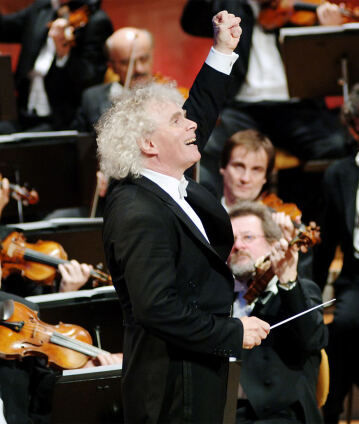Simon Rattle conducts “Pictures at an Exhibition” at the 2007 New Year’s Eve Concert

On New Year’s Eve 2007, the Berliner Philharmoniker and Simon Rattle ushered in the new year with the finest of Russian music. In addition to famous highlights such as Modest Mussorgsky’s Pictures at an Exhibition and Alexander Borodin’s Polovtsian Dances, there was also a new discovery: Borodin’s Second Symphony, a masterpiece which combines the power of Russian folk music with a lyrical magic that recalls the world of the fairy tale.
Together with their colleagues César Cui, Mili Balakirev and Nikolai Rimsky-Korsakov, Borodin and Mussorgsky formed the so-called “Mighty Handful” of composers in the Russia of the 1860s. Their aim was to revive Russian music in the spirit of the country’s folk music. The Polovtsian Dances from Borodin’s unfinished opera Prince Igor are correspondingly lively, whereas the same composer’s Second Symphony may be regarded as a kind of Russian Eroica, a masterpiece which combines the power of Russian folk music with a lyrical magic that recalls the world of the fairy tale and which is heard far too rarely.
Following the interval the orchestra played the prelude to Mussorgsky’s Khovanshchina, with its prominent part for what Der Tagesspiegel termed Wenzel Fuchs’s “divine clarinet”. Other members of the orchestra had a chance to shine in Ravel’s orchestration of Mussorgsky’s multifaceted Pictures at an Exhibition. And yet, as the critic of the Berliner Morgenpost noted, “none of the exquisite soloists stood out at the expense of the whole or substituted vanity for ability. The predominant mood was one of disciplined exuberance and total dedication to the music at the moment of its making”. At the end the enthusiastic audience demanded an encore, which it received in the form of what Sir Simon has called the “mad music” of Shostakovich’s Polka from his ballet suite The Golden Age.
© 2007 EuroArts Music International
Category
Artists
Our recommendations
- 2015 New Year’s Eve Concert with Simon Rattle and Anne-Sophie Mutter
- The 2011 New Year’s Eve Concert with Simon Rattle and Evgeny Kissin
- 2014 New Year’s Eve Concert with Simon Rattle and Menahem Pressler
- 2017 New Year’s Eve Concert with Simon Rattle and Joyce DiDonato
- Sir Simon Rattle conducts a Mozart Gala at the 2005 New Year’s Eve Concert
- Simon Rattle conducts Bernstein’s “Wonderful Town” at the 2002 New Year’s Eve Concert